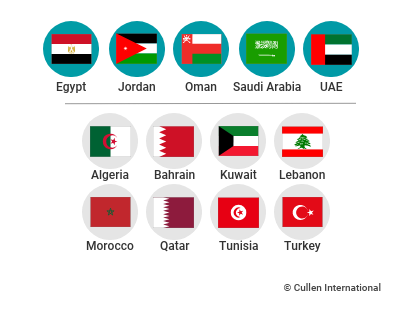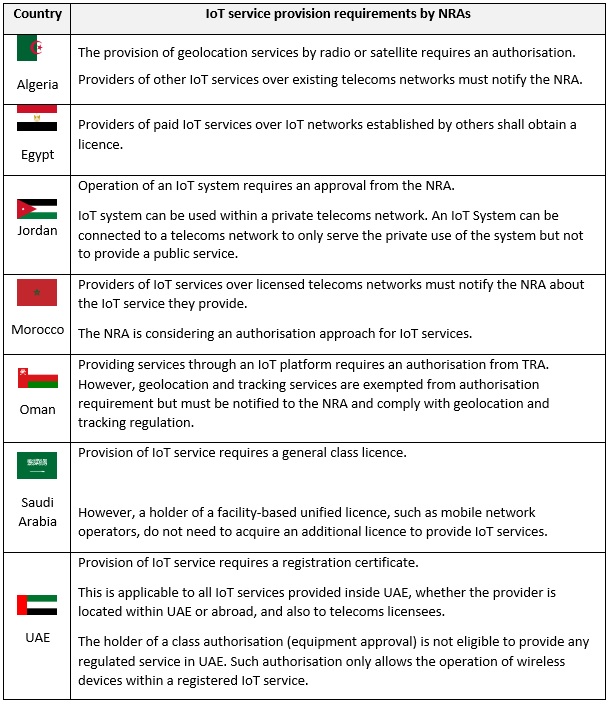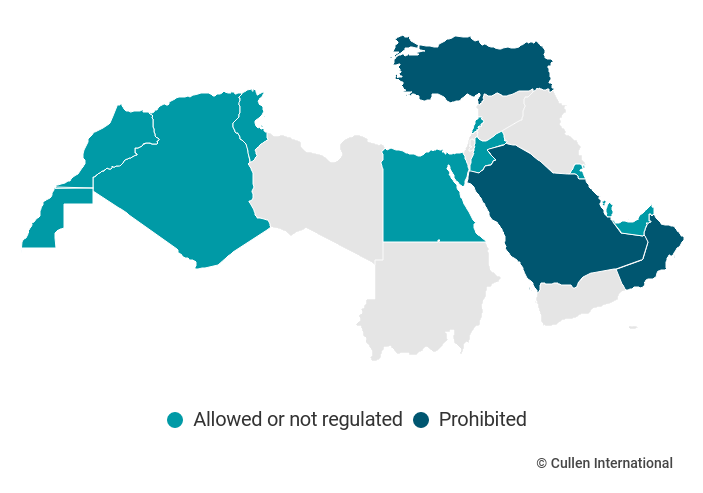Industry Thought Leadership
Provision of IoT Service Requirements in MENA Region
July, 2022Globally, a growing number of telecommunications and ICT service providers are trying to ensure the interaction of connectivity services with a range of new services such as internet of things (IoT) and machine to machine (M2M) communications.
IoT refers to communication between devices that may have limited or no human interaction, connected to the Internet through multiple networks.
Middle Eastern and North African countries (MENA) have shown an active effort to facilitate the rapid deployment of IoT/M2M platforms by formulating the regulatory framework that defines the ability of providing such services.

Cullen International has researched the IoT regulatory frameworks in 13 MENA countries including Algeria, Bahrain, Egypt, Jordan, Kuwait, Lebanon, Morocco, Oman, Qatar, Saudi Arabia, Tunisia, Turkey, and United Arab Emirates (UAE).
Among these countries only five have established a specific regulatory framework for IoT. The IoT regulations in the five countries set general requirements such as licensing requirements for IoT service provision and for IoT connectivity.
In other countries, there are often no specific rules applying to IoT services, which are subject only to the normal telecoms and spectrum licensing framework.
Only licensed telecoms service providers can provide connectivity to IoT devices and systems. However, NRAs in some countries adopted specific requirements for the provision of IoT connectivity.
In Egypt, the NRA defined three types of networks that can provide IoT connectivity:
- a mobile network;
- a non-cellular LPWAN network; and
- a satellite network
Non-cellular LPWAN networks and satellite networks are subject to licence requirements while a licensed mobile network operator needs to apply for an annex to its licence.
In Saudi Arabia, IoT connectivity can be provided by a general class licence holder with specific authorization to provide internet of things over virtual network operator and/or using license-exempt frequencies. A facility-based operator can provide IoT connectivity without the need for additional licence and to use licence-exempted frequency bands.
The NRA of Saudi Arabia suggested a new licensing regime for IoT networks. The IoT connectivity provider would have separate obligations from IoT solution providers. For the latter, no licensing nor registration would be required.
In UAE, the NRA decides on a case-by-case basis if the provision of IoT-specific connectivity requires a licence or not. Licensed telecoms operators can use their networks to provide IoT connectivity without the need for an additional licence.

There are two options for global operators seeking to arrange IoT connectivity for their clients:
either permanent roaming, so a foreign SIM and foreign number will be use permanently in a given country
local profile, means that the SIM card comprises of the operator data related to a subscription, including IMSI with the operator’s credentials and any operator or third-party SIM based applications that would have otherwise been stored on a traditional SIM card.
This paper only discusses regulation of permanent roaming in MENA region. In Egypt and Jordan, use of permanent roaming requires signing an agreement between the national mobile operator and the foreign operator who owns the SIM card installed in the IoT device. In Egypt such agreements must be approved by the NRA.
Although it is possible to use roaming for the provision of an IoT service using roaming, the provider of the IoT service is still subject to the IoT service provision requirements.

Cullen International closely monitors the developments in this extremely fast-growing sector worldwide and carries out benchmarking analyses of the national initiatives on IoT/M2M regulations, policies and strategies. Particular emphasis has been given in this initial phase on the connectivity between these devices across national borders. The deployment of IoTs depends on the cross-border connectivity. The expansion of IoTs has a transnational character evolving their ability to communicate with each other regardless of location, country of installation and distance between them.
The global IoT connectivity solution is a key element of its success. It can be achieved either by permanent roaming or local SIM profiles and by using foreign numbers in the countries of the benchmark or national numbers outside the countries.

